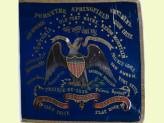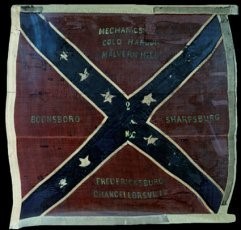 Why am I choosing to write about the Flags of the Civil War, and especially why am I writing now? It’s really quite simple. I want my grandchildren to ignore the “politically correct” rhetoric and learn to look at all sides of a situation before making rash decisions about right and wrong. You see, my wife and I were both raised in the North, but have lived in Texas for many years. We have seven grandchildren. Three of them live in Wisconsin and one in New Hampshire, both Union states. The other three are in Texas, a Confederate state. Now if they were about three years older, and the year was 1861, it is quite possible that they would be fighting against each other, and possibly killing each other. Almost 2.4% of the U.S. population at the time died during that war, so the chances of a death in the family were quite high. In fact, there were more American deaths during the Civil War than all of the wars we have fought since that time combined – approximately 750,000.
Why am I choosing to write about the Flags of the Civil War, and especially why am I writing now? It’s really quite simple. I want my grandchildren to ignore the “politically correct” rhetoric and learn to look at all sides of a situation before making rash decisions about right and wrong. You see, my wife and I were both raised in the North, but have lived in Texas for many years. We have seven grandchildren. Three of them live in Wisconsin and one in New Hampshire, both Union states. The other three are in Texas, a Confederate state. Now if they were about three years older, and the year was 1861, it is quite possible that they would be fighting against each other, and possibly killing each other. Almost 2.4% of the U.S. population at the time died during that war, so the chances of a death in the family were quite high. In fact, there were more American deaths during the Civil War than all of the wars we have fought since that time combined – approximately 750,000.
So, what does this have to do with Flags? Well, recently it seems that the Confederate Flag has taken on the persona of something very evil in the eyes of many Americans. I struggle to call them Americans, because I personally believe that they are trampling on one of the basic fabrics with which the United States of America was built. It is part of the history of a significant portion of the States represented by our current Flag.
Throughout much of history, in time of war, the flag has always been one of the most important pieces of battlefield equipment. During battle, the Civil War flags gave soldiers a rallying point. When battle was raging, it was impossible for units to stay together or for commanders to know exactly what was going on without the flags. Flags identified groups of men as friend or enemy, and allowed commanders to know what movements were being taken by their various units. When men became separated from their units they could identify their unit by its battle flag, or at least pick out their national flag so that they would know which direction would lead them back to their comrades.

Flags also have a major psychological impact in battle as well. This was definitely true of Civil War flags. There was nothing more disgracing for a unit than to lose its battle flag. The loss of this single piece of cloth could totally shatter a unit’s morale. On the flip side, capturing an enemy flag was a huge morale boost for a unit. The importance of the Civil War flags can be seen in the fact that the Union often gave the Medal of Honor to men who captured a Confederate flag or saved their own flags.

A better description of the power of the flag to the soldiers who fought under it can be found in Union General Joshua Chamberlain’s touching description of the Confederate surrender at Appomattox Court House:
“Lastly, — reluctantly, with agony of expression, — they tenderly fold their flags, battle-worn and torn, blood-stained, heart-holding colors, and lay them down; some frenziedly rushing from the ranks, kneeling over them, clinging to them, pressing them to their lips with burning tears. And only the Flag of the Union greets the sky! “ (www.americancivilwarhistory.com)
That Union Flag has grown into the American Flag of today, but now, we are told that the Confederate Flag must no longer be displayed publicly in this “free” nation. In other words, let’s forget that 290,000 young Confederate soldiers died and another 137,000 were wounded, with others dying of various accidents and diseases. They were called Confederates and Rebels, but they were still Americans. Similar losses were felt on the Union side.
Why? Why did these young men die? We hear that it was because the South wanted to retain its Slaves and the Union wanted to prevent the spread of Slavery, and by and large this seems to be true. Without question, slavery is wrong, although, in many forms, it was prevalent throughout much of the world at the time. What is also true is that the North was building a more industrialized society, while the South relied more on agriculture, and Cotton was “King.” It grew into that exalted position no doubt on the backs of inexpensive Slave labor. Here is where the lines get fuzzy.
Because of the inexpensive labor costs, the South was able to sell its cotton into the open world markets, reaping a sizable profit, much of which was used to purchase industrial products from the same world market at less cost than offered by the newly emerging industrial markets of the North. So, we have a conundrum. The North couldn’t sell its products to the South because the South could buy similar products cheaper overseas. Take away the inexpensive Slave Labor and the cost of a bale of cotton would increase substantially, thus cutting profits and eliminating the ability to purchase industrial goods abroad. Simply stated, both sides had economic incentives for their positions.
Other reasons such as Sectionalism, Protectionism and States Rights have also been offered to explain the “War”, but I’ll leave those to another time.
 Now, if you’ve followed me this far, let’s get down to the flags. The 750,000 young men who were wounded or died during 1861 to 1865 were not fighting for or against slavery. That was left to the politicians and power brokers. These young men were fighting for their flag which represented their families and their homes, and they laid down their lives for that flag. What right do we have to attempt to remove that flag from our public places because of some less than honorable wishes of possibly corrupt, but certainly powerful, patriarchs of society. Several of my ancestors fought for one or the other of these flags, and, if this war was to be repeated today, I’m sure several of my grandchildren would be fighting for one or the other of those very same flags.
Now, if you’ve followed me this far, let’s get down to the flags. The 750,000 young men who were wounded or died during 1861 to 1865 were not fighting for or against slavery. That was left to the politicians and power brokers. These young men were fighting for their flag which represented their families and their homes, and they laid down their lives for that flag. What right do we have to attempt to remove that flag from our public places because of some less than honorable wishes of possibly corrupt, but certainly powerful, patriarchs of society. Several of my ancestors fought for one or the other of these flags, and, if this war was to be repeated today, I’m sure several of my grandchildren would be fighting for one or the other of those very same flags.
Take away its flag and you are dismantling its history. A flag is a flag. It is neither good nor bad. It represents different things to different people, and unless someone rewrote our Constitution when I wasn’t looking, we have the right to those differing opinions. Confederate or Union, families are proud of their ancestors who fought for and under the flag of their homeland. To them the flag is a symbol of that pride. Why destroy that symbol?
Note:
The data presented herein for the most part are strictly my personal opinions and are subject to my interpretation of various articles I have read or classes I have taken over the years. I believe they fairly represent the points I am trying to convey, but should not be taken as irrefutable fact.